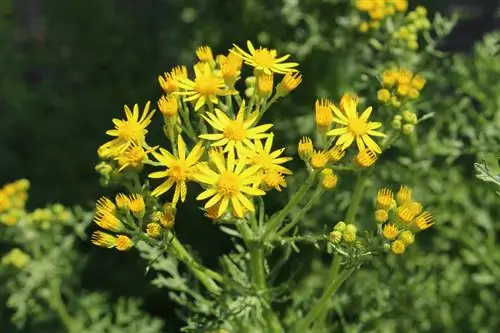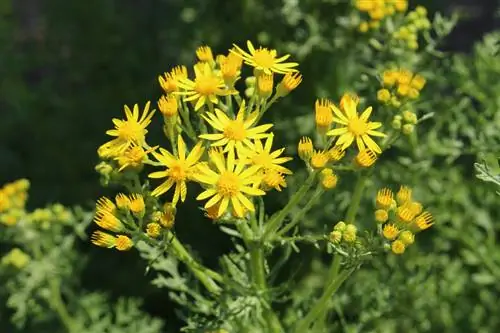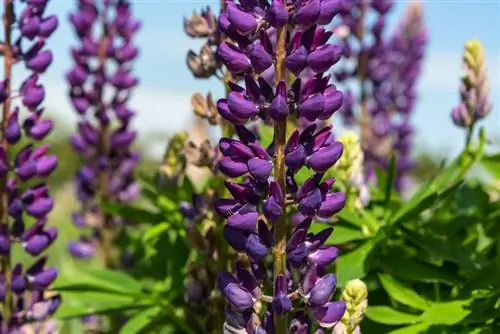- Author admin [email protected].
- Public 2023-12-16 16:46.
- Last modified 2025-01-23 11:20.
This yellow-flowering plant, also known as ragwort, has been spreading massively in recent years. Poisoning due to the alkaloids it contains not only occurs in animals, but also poses a he alth risk for humans. In order to avoid confusion with non-toxic plants and to protect domestic and pasture animals, it is important that you clearly identify ragwort and from others Be able to distinguish between plants.

How do you recognize ragwort?
You can recognize ragwort by its bright yellow flower heads in corymbs, highly dissected, pinnate leaves and angular, twisted stem. Crushed leaves produce an unpleasant smell. The plant is poisonous and dangerous for humans and animals.
Descriptions
The ragwort is also popularly known by the names
- Scalloped ragwort
- Spiderweed
- Toadweed
- Zehrkraut
known. The plant gets its name from groundsel because of the white seed heads, which, like dandelions, serve to spread the seeds. They already appear during the flowering period. The Latin name of the plant Senecio also means old man.
Indicative features
The ragwort immediately catches the eye on fallow land with its bright yellow flower heads. In meadows and pastures, however, the poisonous plant is often only recognized at second glance, as many plants that bloom in June also have yellow flowers.
Size
Depending on the location, the plant reaches a size of between 30 and 100 centimeters. Under favorable conditions it can even grow up to 120 centimeters. In the first year, only the basic rosette with leaves about 20 centimeters long appears. Their appearance is similar to that of kale. Only from the second year onwards does the ragwort grow into small bushes.
Stems and leaves
The ragwort forms an angular, twisted and strong stem that often has a reddish-brown or purple shimmer and is sometimes hairy like a cobweb.
The pinnate (term for a leaf that consists of several leaves) leaves are highly dissected and arranged alternately. They are relatively fibrous and often covered with a cobweb-like down on the underside. The side tips protrude at right angles. When the plant is in full bloom, the basal leaves have already withered.
The ragwort that is not in flower can be identified relatively clearly by the smell of the crushed leaves. They have a very unpleasant, almost nauseating smell.
Flowers
The bright yellow, 15 to 20 millimeter large flower heads of the daisy family grow in upright clusters. Their structure is similar to daisy flowers. There are 13 ray florets around the inner, disc-shaped wreath. However, as with all composite plants, the number of these can vary.
The bud cover consists of 13 black-tipped cover leaves and two close-fitting outer cover leaves.
Flowering time
The ragwort blooms from June to August.
Roots
The ragwort forms a strong and deep taproot with numerous fine fibrous roots.
Occurrences
The ragwort thrives at altitudes of around 1000 meters. It prefers dry, moderately nutrient-rich, loamy clay soils. It prefers to settle on rarely mown agricultural areas, on paths, roads and railway embankments and on fallow land.
Special feature
In spring, the ragwort is often colonized by the black and yellow caterpillars of the ragwort bear. Specialized on the host plant, the caterpillars are not harmed by the toxins they ingest, but are themselves inedible for other animals. The plant can be reliably identified based on the appearance of these caterpillars.
The ragwort is one of the dangerous poisonous plants
All parts of the plant contain the toxins jacobin and senecionine. Young plants and flowers contain the highest concentration of poison. The toxins also remain effective in hay and silage.
The poison of the ragwort is metabolized in the liver and is not directly toxic. The alkaloids also get into food via the food chain. These have already been detected in eggs, milk, honey and chamomile tea.
Dangerous for humans and animals
Although ragwort is not on the list of poisonous plants, it is very dangerous for animals and people. Horses and cattle are very susceptible and die within a few days if acutely poisoned. They refuse food, lose weight rapidly and get bloody diarrhea. Other symptoms of poisoning include obvious lethargy alternating with sudden nervousness. Sheep, pigs and other mammals are not as sensitive to the toxins, but can also die if they are fed contaminated hay regularly.
Control necessary in pastures
Since ragwort is avoided by animals, it can spread extremely quickly under favorable conditions. It is therefore recommended to combat the plant in pastures immediately and in a targeted manner. It is important to ensure that the ragwort does not bloom, because the small seed umbrellas spread for kilometers and remain viable for years. Ragwort can be controlled both biologically and chemically.
Tip
Animals have good instincts and often do not eat poisonous plants. In addition, fresh ragwort tastes very bitter. However, dry plant parts in hay are extremely dangerous because the animals cannot eliminate the poisonous plant. Poisoning can progress slowly and inevitably leads to the death of the animal.






